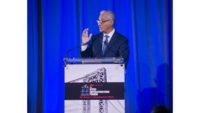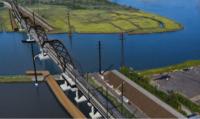NJ Transit was beset with maintenance and safety issues well before the fatal Sept. 29 passenger train crash at the Hoboken station, according to recent testimony from the agency’s newly appointed executive director.
Stephen H. Santoro, who took over the rail agency in mid-October, told a Nov. 4 state legislative hearing that a Federal Railroad Administration audit completed in June revealed numerous safety violations—from an absence of on-board emergency equipment to lax inspection procedures for locomotive brakes.
Santoro is formerly an assistant executive director who oversaw capital projects and is a 16-year veteran of NJ Transit, the third largest U.S. commuter rail system. He assumed the top role permanently after months of turmoil following the departure of Ronnie Hakim, who left on Dec. 28 to become president of NYC Transit.
In April, the job was offered to and accepted by William Crosbie, former president and CEO of North American operations for Paris-based transportation firm SYSTRA and ex-Amtrak chief operating officer. But he then declined the job, with speculation over the reason.
The executive director role had been filled on an interim basis since then by Dennis Martin, a veteran NJ Transit bus operations executive.
Santoro noted that personnel shortfalls had contributed to NJ Transit’s poor safety record as well. The agency’s maintenance staff shrank by 5% between 2010 and 2014, even as daily ridership on its 1,002-mile heavy and light rail network increased to its current level of more than 308,000 weekday passengers.
According to publication NJ Spotlight, the transit agency has 245 open management slots and has had to extract funds from its capital budget to operate. The agency also is down about 20 positions related to positive train control (PTC) implmentation, and lacks a deputy safety systems chief, says the publication. Legislators also questioned the number of former political appointees linked to Gov. Chris Christie (R), who have landed jobs at NJ Transit. They include former Christie press secretary Michael Drewniak, who has been its chief of policy and strategic planning since last year.
While the National Transportation Safety Board has yet to pinpoint the cause of the Hoboken crash, which killed one passenger and injured more than 100 others, its preliminary report found that the train’s speed suddenly increased as it neared the terminal. Whether PTC technology would have prevented the crash is expected to be part of the federal investigation.
NJ Transit is scheduled to begin testing PTC on several miles of its Morris and Essex line next year, although Board Chairman Richard Hammer assured state legislators at an earlier hearing that the agency would meet the federally imposed December 2018 nationwide deadline for implementing PTC.
"PTC implementation has been slow but will likely now be advanced quicker," says one industry executive with knowledge of the agency's program. "The current PTC implementation excludes yards like Hoboken but that may change."
Santoro vowed to take immediate steps to rectify NJ Transit’s safety and maintenance issues, despite the agency’s $22.5-million FY 2016 budget deficit. Measures include ending the practice of using construction funds for day-to-day operations and major equipment purchases, and finding funding to fully staff the agency’s safety office.
Less clear is how NJ Transit will reconcile the prospect of major infrastructure expenditures, such as replacing the century-old Portal Bridge, with the near-doubling of its annual Northeast Corridor track usage payments to Amtrak over the next five years.
After a three-month transportation funding standoff between state politicians that halted hundreds of transit system and road construction projects this summer, legislators and Gov. Chris Christie (R) agreed in early October to a tax compromise that includes a controversial 23-cent-per-gallon gasoline tax. NJ Transit will be among the beneficiaries of the new revenue.
State voters also are considering a ballot issue on Nov. 8 that would create a "lockbox" for the new gas tax revenue, requiring that it be spent only on transit and road construction projects.



Post a comment to this article
Report Abusive Comment